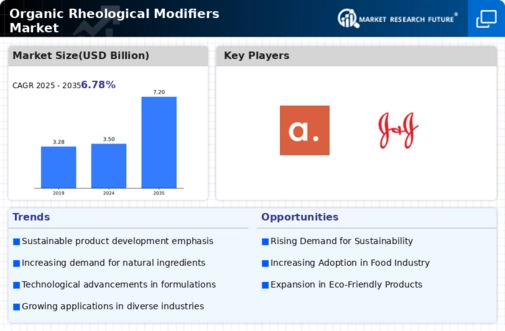Top Industry Leaders in the Organic Rheological Modifiers Market

The organic rheological modifiers market is a dynamic space witnessing intense competition among established players and new entrants alike. To thrive in this environment, companies are adopting diverse strategies, targeting specific niches, and constantly innovating. Let's dive into the landscape, exploring competitive dynamics, market share drivers, key industry news, and recent developments.
Market Strategies:
Diversification: Leading players like BASF, Dow Chemical, and AkzoNobel are expanding their portfolios to cater to a wider range of applications and end-use industries. This includes developing customized solutions for paints, coatings, cosmetics, personal care, pharmaceuticals, and food products.
Innovation: Continuous R&D efforts are crucial for differentiation. Companies are focusing on creating novel organic rheological modifiers with enhanced functionalities, improved sustainability profiles, and lower environmental impact.
Acquisitions and Collaborations: Strategic acquisitions and partnerships enable faster market penetration, access to new technologies, and knowledge sharing. Recent examples include Ashland's acquisition of Hercules and Clariant's collaboration with Arkema for bio-based rheological modifiers.
Regional Expansion: Emerging markets in Asia-Pacific and Latin America offer significant growth potential. Companies are setting up production facilities and establishing distribution networks in these regions to capture emerging opportunities.
Sustainability Focus: Growing consumer awareness and tightening environmental regulations are driving the demand for eco-friendly organic rheological modifiers. Companies are investing in bio-based solutions, using renewable feedstocks, and minimizing waste generation.
Market Share Drivers:
Performance: Rheological modifiers significantly impact the flow, texture, and stability of finished products. Superior performance and consistent results are key differentiators in a competitive market.
Application Diversity: Organic rheological modifiers find applications in numerous industries, each with specific requirements. Offering tailor-made solutions for diverse applications expands market reach and drives market share.
Regulatory Compliance: Stringent regulations governing chemicals and environmental safety necessitate compliance with evolving standards. Companies with a strong focus on regulatory compliance gain a competitive edge.
Branding and Customer Service: Establishing a strong brand reputation and providing excellent customer service foster trust and loyalty, leading to repeat business and increased market share.
Cost-Effectiveness: While performance matters, cost remains a crucial factor. Companies striving for cost-efficient production processes and competitive pricing gain an advantage over competitors.
List of Key Players in the Organic Rheological Modifiers Market
- BASF SE (Germany),
- Evonik Industries AG (Germany)
- AkzoNobel N.V. (Netherlands)
- The Lubrizol Corporation (US)
- Elementis plc (UK)
- Arkema Group (France)
- Clariant (Switzerland)
- Ashland (US)
- Croda International Plc (UK)
- Dow Corning Corporation (US)
Recent Developments:
July 2023: Lubrizol acquires a smaller competitor specializing in bio-based rheological modifiers, strengthening its position in the sustainable materials sector.
August 2023: The European Union proposes new regulations for rheological modifiers in food products, prompting manufacturers to adapt their product offerings.
September 2023: A research consortium publishes a groundbreaking study showcasing the potential of using cellulose nanofibers as sustainable and highly effective rheological modifiers.
October 2023: AkzoNobel unveils a digital platform enabling customers to design and customize their own rheological modifiers for specific applications.
November 2023: BASF wins a prestigious award for its innovative castor oil-based rheological modifier for cosmetics, recognized for its exceptional performance and bio-based content.


